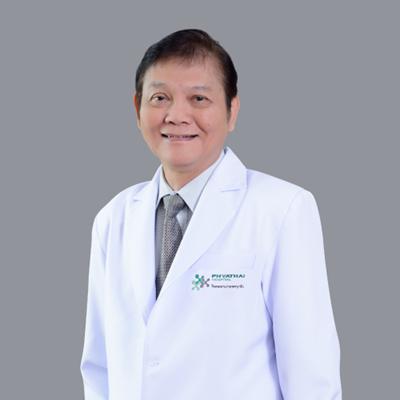
Dr. Prawit Songsaengterm
Dr. Prawit Songsaengterm
General info
Treating bone-related conditions requires multiple supporting factors — understanding the patient, advanced medical technology, a specialized medical team, physical therapy experts, and most importantly, the patient’s own effort in physical rehabilitation. Therefore, the number one starting point in treatment is that the patient must trust the doctor and the team, while the doctor must also be ready to provide both treatment and encouragement throughout the journey.
Expertise comes from a lifetime of experience
Dr. Prawit Songsaengterm, an orthopedic surgeon specializing in bones and joints, has over 32 years of experience caring for patients, and thus deeply understands their needs.
“Patients who come to see a doctor for treatment often have fear and anxiety, especially those who come because of pain caused by bone and joint degeneration. Most of these patients are elderly and typically have two main fears: the fear of pain and the fear of losing mobility. As doctors, we need to alleviate their fears by providing accurate knowledge and understanding. In cases where they fear pain, we show them examples of others who have undergone surgery, while also explaining each step clearly. Seeing real-life examples helps patients understand and feel more at ease.”
For patients who worry that although the pain might go away after surgery, they might not be able to walk, sit, or stand again — Dr. Prawit, having personally undergone knee replacement surgery himself, uses his own experience as an example. He demonstrates standing and sitting to show that one can return to a normal life after surgery.
Understanding the patient’s needs to create an appropriate treatment plan
Dr. Prawit selects treatment methods based on the individual needs of each patient, focusing on improving their quality of life. Nowadays, treatments include both surgical and non-surgical options. Not every patient requires surgery, as the condition is usually not life-threatening. Some choose to manage pain with medication, while others may not tolerate the pain or find no relief from medication, prompting them to opt for surgery to improve their condition.
In terms of surgery, medical technology has advanced significantly. Minimally invasive surgical techniques are now used, and the quality of surgical instruments continues to improve. As a result, modern surgical procedures are more convenient and less painful, aided by more effective painkillers. Most patients can walk again shortly after surgery, with less trauma and shorter recovery times.
A patient’s improved quality of life is the doctor’s joy
“From my experience in patient care, one of the most rewarding things is seeing the patient’s quality of life improve. For instance, one female patient was a homemaker with severely bowed legs. She looked weary and had suffered from chronic pain for years before finally deciding to undergo surgery. The results were remarkable — her knee pain disappeared, and her once-bowed legs straightened. She was able to walk comfortably. With her improved condition came a brighter appearance — she dressed nicely, looked cheerful, and smiled more. It was a complete transformation because she could now walk without pain or discomfort, felt confident because her legs were no longer bowed, and could travel easily, even abroad. Seeing this makes me truly happy, because it’s not just about healing the illness — it’s about restoring the patient’s quality of life and bringing joy and vitality back into their everyday living.”
Education
- N/A Doctor of Medicine., Mahidol University.
Schedule
General Orthopedic
General Orthopedic
General Orthopedic
General Orthopedic
General Orthopedic
General Orthopedic
General Orthopedic
General Orthopedic
General Orthopedic
General Orthopedic
General Orthopedic
General Orthopedic
General Orthopedic
General Orthopedic
General Orthopedic
General Orthopedic
General Orthopedic
General Orthopedic